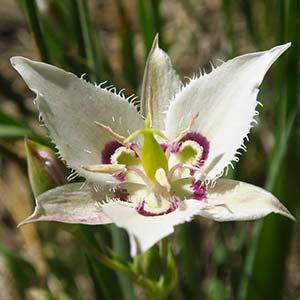Calochortus lyallii
Calochortus amabilis
Lyall's mariposa-lily
Diogenes' lantern, golden fairy lantern
not branching or with branch in axil of cauline leaf, straight, 1–5 dm.
usually branching distal to base, 1–5 dm, slightly glaucous.
basal solitary, persistent, 1–3 dm × 2–20 mm, usually not exceeding inflorescence;
blade tapering toward both ends.
basal persistent, 20–50 cm;
blade linear, flat, slightly glaucous.
subumbellate, 1–9-flowered;
bracts 2–several, lanceolate to linear, attenuate, unequal, 1–5 cm;
peduncle slender, becoming stiffly erect in fruit.
2–many-flowered.
erect or spreading;
perianth open, campanulate;
sepals white or purplish-tinged, usually with purple crescent, lanceolate, usually equaling petals, often adaxially papillose, apex acuminate to attenuate;
petals white or purplish-tinged, usually with median, red-purple, adaxial crescent distal to gland, ovate to lanceolate, abruptly contracted at base into short, conspicuous claw, usually conspicuously fringed with long, slender hairs, adaxial surface ± papillose, bearing a few long hairs distal to claw, apex acute to acuminate;
glands transversely oblong, depressed, arched upward, bordered proximally by narrower, crenate membrane, with short, thick hairs toward distal margin of enclosed surface, both fringe of lower membrane and hairs densely long-papillose;
filaments basally dilated, ± equaling anthers;
anthers oblong-lanceolate, apex acute to short-apiculate.
nodding;
perianth closed at apex, globular;
sepals spreading, ovate to lanceolate, 1.5–2 cm;
petals deep yellow, with brown abaxial blotch, widely lanceolate, 1.6–2 cm, densely ciliate throughout, adaxial surface glabrous or with a few hairs near gland;
glands deeply depressed, bordered distally by band of hairs;
filaments longer than anthers;
anthers oblong, apex obtuse or acute.
erect, 3-winged, ellipsoid, base and apex acute.
nodding, winged, oblong, 2–3 cm, apex obtuse or acute.
irregular.
dark brown, irregular.
= 20.
= 20.


